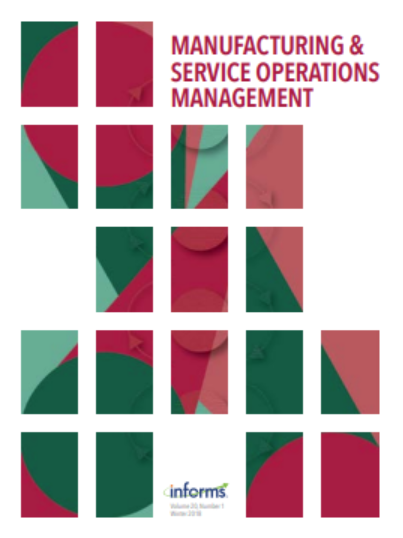Allocation of Nonprofit Funds Among Program, Fundraising, and Administration
IF 4.8
3区 管理学
Q1 MANAGEMENT
M&som-Manufacturing & Service Operations Management
Pub Date : 2023-09-01
DOI:10.1287/msom.2020.0660
引用次数: 0
Abstract
Problem definition: U.S. nonprofits declare three types of expenses in their IRS 990 forms: program spending to meet beneficiaries’ needs; fundraising spending to raise donations; and administration spending to build and maintain capacity. Charity watchdogs, however, expect nonprofits to prioritize program spending over other categories. We study when such expectations may lead to the “starvation cycle” or underspending on administration and fundraising. Methodology/results: We characterize optimal budget allocations to program, fundraising, and administration spending categories using a two-period model, which also includes the nonprofit’s capacity, return on program spending (the net value of program spending to beneficiaries), and beneficiaries’ uncertain future needs. We find that the nonprofit’s capacity plays a significant role in the optimal allocation. The nonprofit should (a) at high capacity, spend only the necessary amount on administration to maintain its current capacity; (b) at moderate capacity, maintain its current capacity while limiting program spending in favor of fundraising; and (c) at low capacity, increase administration spending to expand its future capacity. When we compare the optimal allocations prescribed by our model to the actual spending levels reported by a foodbank network, we find that the foodbank underspends on administration and fundraising, suggesting the forces that lead to the starvation cycle may be in play. Another possibility is that the nonprofit’s own estimate of its return on program spending is higher than our estimate—At higher estimates of return on program, the gap between our prescribed solutions versus actual spending levels decreases. Managerial implications: Our paper introduces an important discussion on nonprofits’ starvation cycle and finds conditions that justify prioritizing administration and fundraising expenses. It also highlights that watchdogs should consider nonprofits’ return on program spending in addition to their capacity and future needs when evaluating them. Funding: T. O. Kotsi thanks the Onassis Foundation (Greece) for financial support. Supplemental Material: The online appendix is available at https://doi.org/10.1287/msom.2020.0660 .非营利性基金在项目、筹款和管理中的分配
问题定义:美国非营利组织在其IRS 990表格中申报三种类型的支出:满足受益人需求的项目支出;筹集捐款的支出;以及用于建设和维持能力的行政支出。然而,慈善监督机构希望非营利组织优先考虑项目支出,而不是其他类别。我们研究了这种期望何时会导致“饥饿周期”或在管理和筹款方面的支出不足。方法/结果:我们使用一个两期模型来描述项目、筹款和管理支出类别的最佳预算分配,该模型还包括非营利组织的能力、项目支出的回报(项目支出对受益人的净值)和受益人不确定的未来需求。我们发现,非营利组织的能力在最优配置中起着重要作用。非营利组织应该(a)在高容量时,只花费必要的管理费用来维持其当前的能力;(b)在中等能力下,维持其目前的能力,同时限制有利于筹款的项目支出;(三)在产能不足的情况下,加大行政管理支出,扩大未来产能。当我们将我们的模型规定的最佳分配与食物银行网络报告的实际支出水平进行比较时,我们发现食物银行在管理和筹款方面的支出不足,这表明导致饥饿周期的力量可能在发挥作用。另一种可能性是,非营利组织自己对项目支出回报的估计高于我们的估计——项目回报的估计越高,我们规定的解决方案与实际支出水平之间的差距就越小。管理意义:我们的论文对非营利组织的饥饿周期进行了重要的讨论,并找到了证明优先管理和筹款费用合理的条件。它还强调,监管机构在评估非营利组织时,除了考虑其能力和未来需求外,还应考虑其项目支出的回报。资金:T. O. Kotsi感谢奥纳西斯基金会(希腊)的资金支持。补充材料:在线附录可在https://doi.org/10.1287/msom.2020.0660上获得。
本文章由计算机程序翻译,如有差异,请以英文原文为准。
求助全文
约1分钟内获得全文
求助全文
来源期刊

M&som-Manufacturing & Service Operations Management
管理科学-运筹学与管理科学
CiteScore
9.30
自引率
12.70%
发文量
184
审稿时长
12 months
期刊介绍:
M&SOM is the INFORMS journal for operations management. The purpose of the journal is to publish high-impact manuscripts that report relevant research on important problems in operations management (OM). The field of OM is the study of the innovative or traditional processes for the design, procurement, production, delivery, and recovery of goods and services. OM research entails the control, planning, design, and improvement of these processes. This research can be prescriptive, descriptive, or predictive; however, the intent of the research is ultimately to develop some form of enduring knowledge that can lead to more efficient or effective processes for the creation and delivery of goods and services.
M&SOM encourages a variety of methodological approaches to OM research; papers may be theoretical or empirical, analytical or computational, and may be based on a range of established research disciplines. M&SOM encourages contributions in OM across the full spectrum of decision making: strategic, tactical, and operational. Furthermore, the journal supports research that examines pertinent issues at the interfaces between OM and other functional areas.
 求助内容:
求助内容: 应助结果提醒方式:
应助结果提醒方式:


